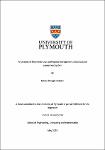An analysis of the Iranian post-earthquake management and structural assessment system
| dc.contributor.supervisor | Kim, Boksun | |
| dc.contributor.author | Razaghi-Kashani, Nirvan | |
| dc.contributor.other | School of Engineering, Computing and Mathematics | en_US |
| dc.date.accessioned | 2023-07-06T08:11:28Z | |
| dc.date.available | 2023-07-06T08:11:28Z | |
| dc.date.issued | 2023 | |
| dc.identifier | 345973 | en_US |
| dc.identifier.uri | https://pearl.plymouth.ac.uk/handle/10026.1/21019 | |
| dc.description.abstract |
This thesis investigated the theory and practice of structural assessment, as a component in a more extensive post-earthquake disaster management system. The research focused on Iran as a case study, and in particular the capital city of Iran (Tehran). This study aimed overview of the system used for post-earthquake disaster management and structural assessment in Tehran. This thesis examined three specific sub-components of the system, namely: The Earthquake Information Management System (EIMS), seismic hazard education programs, and initiatives to engage communities in the disaster management process. A blended phenomenological and ethnographic approach provided the basis for the analysis of collected data and results from the research has provided new insights about how to enhance urban resilience; by improving systems used to manage post-earthquake structural assessment. This research utilized a mixture of phenomenological and ethnographic methods. In this research, phenomenological method was used by the author to study the experience and behavior of ordinary people in Tehran, towards the post-earthquake structural assessment within disaster management system. The utilization of phenomenological research method enables the identification of patterns how concerning individuals residing in Tehran perceive and interpret significant life events such as earthquake. Therefore, this study used an Interpretative Phenomenological Analysis (IPA) approach to define and make judgements about strengths and weaknesses in the Iranian earthquake management system, and in particular the post-earthquake structural assessment system. The ethnographic element of this research involved the author travelling to Tehran and living for a period of time in the community, while collecting useful data for the project. For the of gathering data, a questionnaire survey was conducted, targeting Three communities within the Tehran population: residents of multi-story reinforced concrete residential buildings (N=151), professional civil/structural engineers (N=20) and representative of organizations responsible for managing the Iranian EIMS (N=4). The results obtained in this research study were divided in four main chapters, where the first chapter is about EIMS in Iran. While the second chapter focuses on the post-earthquake structural assessment system in Iran. The third chapter explores opportunities to enhance education programs within the EIMS and linked to post-earthquake structural assessment. Lastly, the fourth and final chapter explores opportunities to enhance engagement within post-earthquake structural assessment activities. For each element of the results, the author has structured a narrative around a relevant piece of observational data that he collected during his visit to Tehran. In this thesis, the obtained results utilize observation as a mechanism to bring attention to new learning and convey new understanding arising from the analysis of collected data. Following the principals of ethnographic research, the author initiates the analysis by examining the phenomenological data from the perspective of their personal research journey. Subsequently, the author proceeds to analyze the quantitative results obtained from the survey. This research was able to verify some of the findings from prior studies that looked at elements of the earthquake management system in Iran and was able to contribute new knowledge about the extent to which recent efforts by local authorities have improve the systems in operation. In addition, the IPA approach was judged to be successful in revealing previously unreported detail about strengths and weaknesses in both the EIMS and post-earthquake structural assessment systems of Iran. Finally, the ethnographic analysis enabled the author to contribute a well-grounded and evidence-based set of proposals outlining ways in which the EIMS and post-earthquake structural assessment systems of Iran could be improved with more structured education and engagement programs. | en_US |
| dc.language.iso | en | |
| dc.publisher | University of Plymouth | |
| dc.subject | disaster management | en_US |
| dc.subject | structural assessment | en_US |
| dc.subject.classification | PhD | en_US |
| dc.title | An analysis of the Iranian post-earthquake management and structural assessment system | en_US |
| dc.type | Thesis | |
| plymouth.version | publishable | en_US |
| dc.identifier.doi | http://dx.doi.org/10.24382/5059 | |
| dc.rights.embargoperiod | No embargo | en_US |
| dc.type.qualification | Doctorate | en_US |
| rioxxterms.version | NA |
Files in this item
This item appears in the following Collection(s)
-
01 Research Theses Main Collection
Research Theses Main


